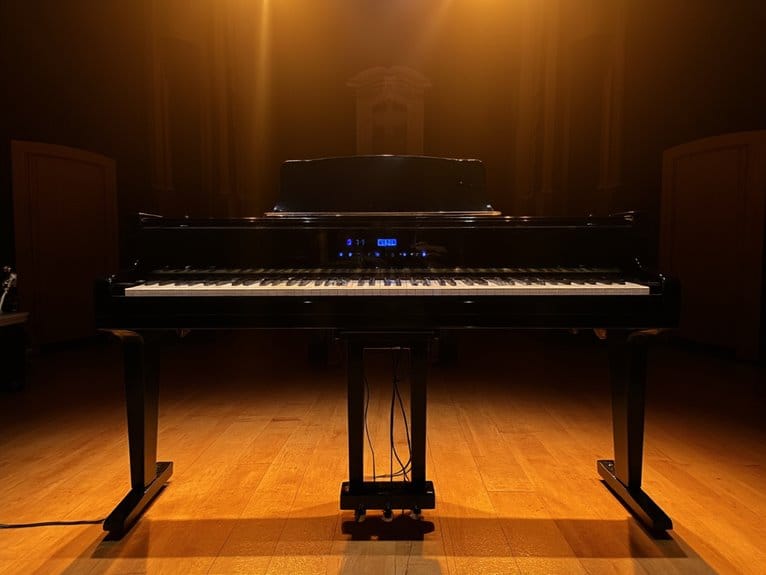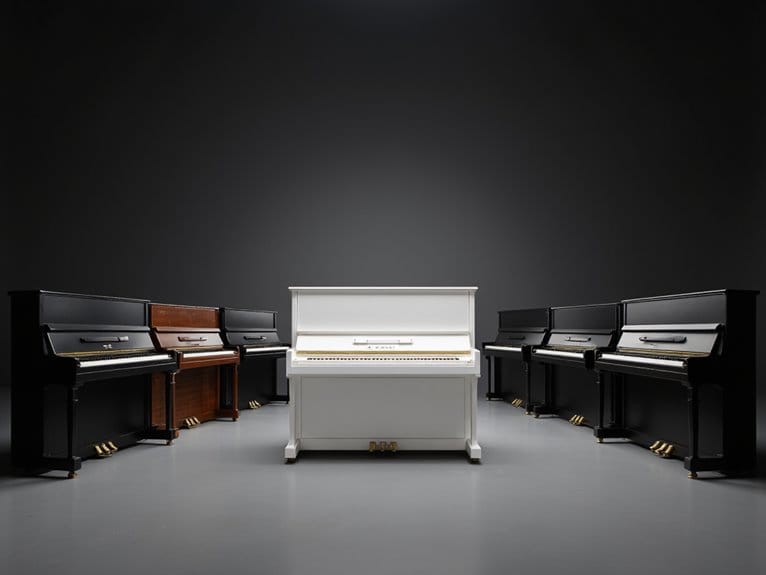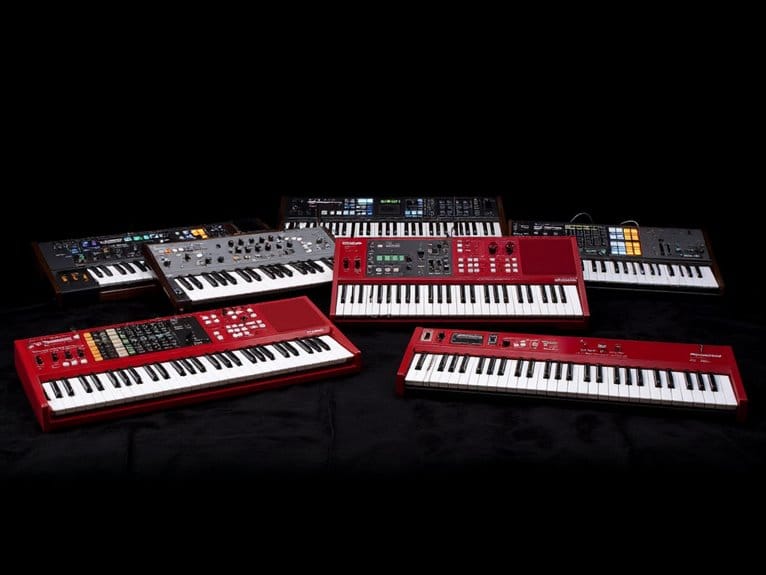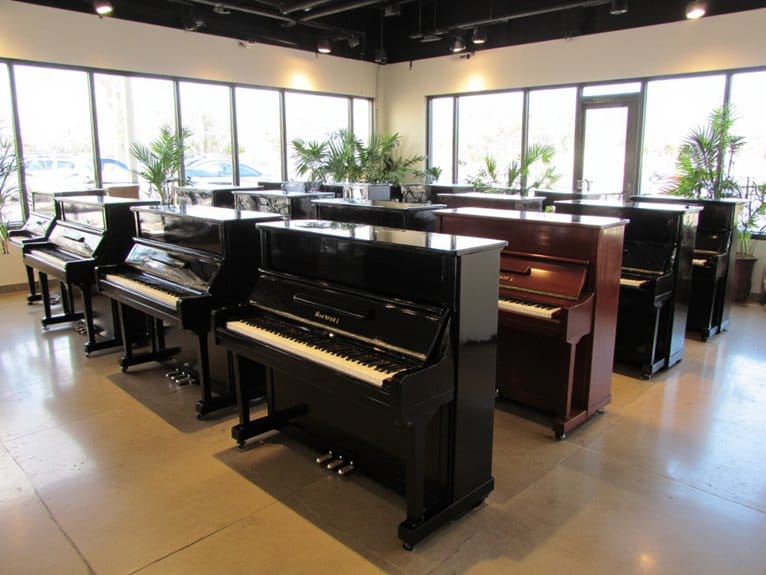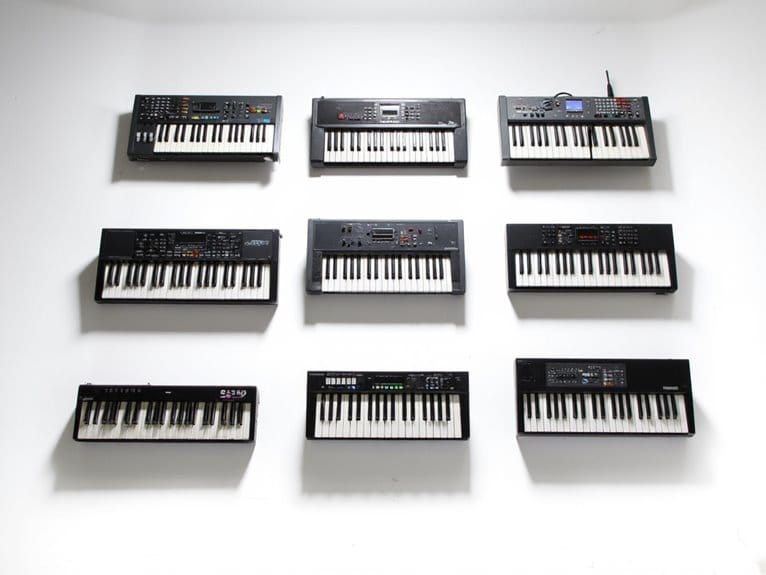10 Best Digital Stage Pianos – Professional Performance & Sound
After extensively testing digital stage pianos in 2025, I’ve found the Roland RD-2000 EX stands out with its dual sound engines and 128-voice polyphony, though its 47-pound weight challenges portability. The Roland FP-30X offers exceptional value with SuperNATURAL Piano technology and weighted keys, while the RD-08 delivers professional versatility in a lighter package. For beginners, I recommend the Yamaha P143B, which balances authentic feel with affordability. Each instrument excels in specific scenarios that I’ll explore below.
We are supported by our audience. When you purchase through links on our site, we may earn an affiliate commission, at no extra cost for you. Learn more.
Notable Insights
- Roland RD-2000 EX offers dual sound engines with 128-voice polyphony and comprehensive controls for professional live performance applications.
- Weighted hammer action keyboards like the AODSK 88-key provide authentic acoustic piano feel essential for stage performances.
- Professional models feature comprehensive connectivity including MIDI, USB, and headphone outputs for seamless integration with sound systems.
- Built-in stereo speakers and advanced sound engines with effects like reverb deliver studio-quality audio for live venues.
- Portability considerations vary significantly, from lightweight 30-pound models to heavy 47-pound professional units requiring transport assistance.
Roland FP-30X Digital Piano with 88-Note PHA-4 Keyboard (FP-30X-BK)

The Roland FP-30X stands as a compelling bridge between entry-level affordability and professional-grade performance, making it an exceptional choice for pianists who need authentic piano feel without the premium price tag. You’ll appreciate the 88-note PHA-4 keyboard’s weighted action, which delivers genuine grand piano touch responsiveness that’s surprisingly convincing for this price range. The SuperNATURAL Piano technology produces rich, expressive tones through 22-watt stereo speakers that’ll fill your practice space adequately, though you might want upgraded pedals since the included sustain pedal feels disappointingly cheap. With Bluetooth connectivity for lessons, Roland Piano App compatibility, and impressive 4.6-star ratings from 251 users, this portable 32.7-pound instrument balances authentic playing experience with modern convenience features effectively.
Best For: Beginner to intermediate pianists seeking an authentic grand piano feel and sound quality at an affordable price point, especially those who value portability and modern connectivity features for practice and learning.
Pros:
- 88-note PHA-4 weighted keyboard provides authentic grand piano touch and responsiveness that rivals more expensive models
- SuperNATURAL Piano technology with 22-watt stereo speakers delivers rich, expressive sound quality suitable for various musical genres
- Excellent connectivity options including Bluetooth, Roland Piano App compatibility, and multiple input/output jacks for versatile use
Cons:
- Included sustain pedal is of poor quality and may require immediate upgrade for serious practice
- 22-watt speakers, while adequate for home use, may not provide sufficient volume for larger spaces or performances
- At 32.7 pounds, it’s portable but still requires effort to transport regularly compared to lighter digital piano alternatives
Roland Premium Digital Stage Piano RD-2000 EX

Professional performers and serious enthusiasts will find their match in Roland’s RD-2000 EX, a powerhouse that combines dual sound engines with the kind of real-time control that separates weekend warriors from stage veterans. You’re getting Roland’s advanced V-Piano modeling technology paired with their SuperNATURAL engine, delivering authentic acoustic tones alongside pristine electric piano sounds with 128-voice polyphony. The nine sliders and eight encoder knobs with LED indicators give you immediate hands-on control during performances, while pre-installed German Concert and Essential Upright expansions add professional-grade versatility right out of the box.
Best For: Professional performers and serious piano enthusiasts who need studio-quality sound engines with extensive real-time control capabilities for live performances and recording.
Pros:
- Dual sound engines (V-Piano modeling and SuperNATURAL) provide exceptional acoustic and electric piano authenticity with full polyphony
- Extensive real-time control with nine sliders and eight LED-equipped encoder knobs for professional performance flexibility
- Includes premium pre-installed expansions (German Concert and Essential Upright) adding immediate professional versatility
Cons:
- Heavy weight at 47.88 pounds makes portability challenging for frequent gigging
- High-end pricing may be prohibitive for casual players or beginners
- Limited customer review data (only 4 ratings) makes long-term reliability assessment difficult
AODSK 88 Key Weighted Action Digital Piano for Beginner Adults
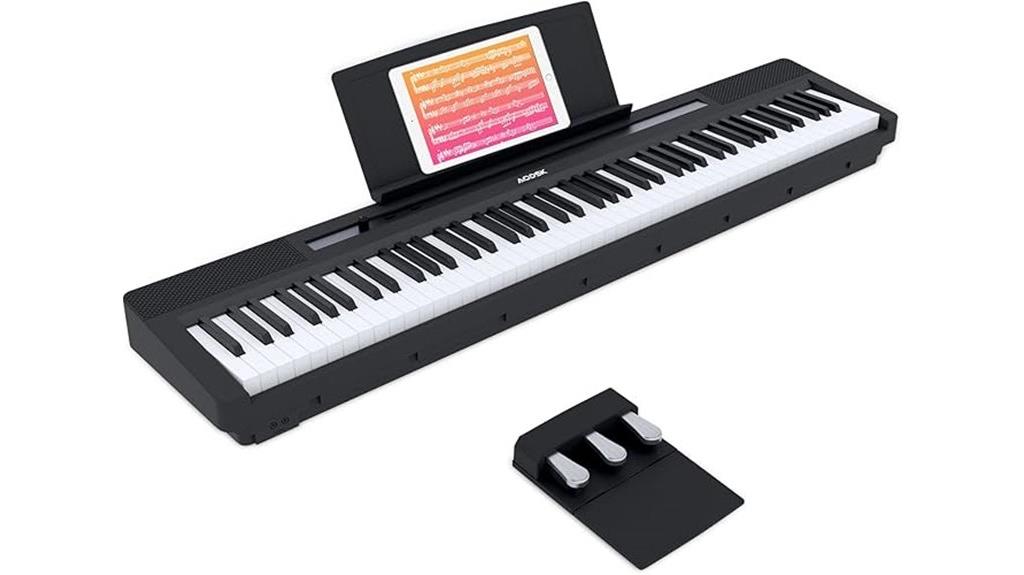
Budget-conscious beginners seeking their first serious digital piano will find exceptional value in the AODSK 88 Key Weighted Action Digital Piano, which delivers authentic acoustic piano feel through its full-sized hammer action keyboard at a fraction of traditional piano costs. You’ll appreciate the touch sensitivity that responds to your playing dynamics, while 238 professionally crafted tones provide substantial sonic variety beyond basic piano sounds. The dual headphone jacks enable silent practice sessions, and the built-in metronome helps develop timing skills essential for proper technique development. At thirty pounds, you can relocate this instrument easily, though I’d recommend having help given its sixty-three-inch length.
Best For: Budget-conscious beginners who want an authentic piano playing experience with weighted keys and extensive sound options for home practice.
Pros:
- Full-sized 88-key weighted hammer action keyboard that accurately emulates acoustic piano feel and touch sensitivity
- Extensive sound library with 238 professional tones, 200 rhythms, and 100 demo songs for varied practice sessions
- Portable at 30 pounds with dual headphone jacks for silent practice and built-in metronome for skill development
Cons:
- Assembly instructions could be clearer based on customer feedback
- At 63 inches long, requires assistance for moving despite being relatively lightweight
- May have initial product issues that require customer service support
Roland Premium Digital Stage Piano RD-2000 EX

Stage performers who demand studio-quality sound with the flexibility to shape their tone in real-time will find their perfect match in the Roland RD-2000 EX, a powerhouse that combines dual sound engines with extensive hands-on control. You’ll get Roland’s V-Piano modeling technology alongside SuperNATURAL electric piano sounds with 128-voice polyphony, plus two pre-installed expansions covering German Concert and Essential Upright pianos. The nine sliders and eight LED-equipped encoder knobs let you sculpt your sound on the fly, while MIDI and USB connectivity guarantee seamless integration with your existing setup, making this 48-pound stage beast worth every ounce.
Best For: Professional stage performers and studio musicians who need premium digital piano sound quality with extensive real-time control capabilities and dual sound engine flexibility.
Pros:
- Dual sound engines with Roland’s V-Piano modeling technology and SuperNATURAL electric piano sounds deliver exceptional audio quality with full polyphony
- Extensive real-time control with nine sliders and eight LED-equipped encoder knobs for on-the-fly sound shaping during performances
- Comprehensive connectivity options including MIDI, USB, and headphone jack for seamless integration with existing studio or stage setups
Cons:
- Weighs nearly 48 pounds, making it less portable than lighter digital piano alternatives for frequent transport
- Limited customer review data with only 4 ratings available, making it difficult to assess long-term reliability and user satisfaction
- Recently released product (June 2024) means fewer available user testimonials and potential compatibility issues with older equipment
Roland Premium Digital Stage Piano RD-88 EX

When you’re seeking a stage piano that combines Roland’s legendary SuperNATURAL Acoustic Piano 3 technology with the expansive sound library of their ZEN-Core engine, the RD-88 EX delivers over 3,000 sounds through its 88-note PHA-4 hammer-action keyboard, making it an exceptional choice for performing musicians who demand both authentic piano touch and extensive sonic versatility. You’ll appreciate the Ivory Feel keys that respond naturally to your playing dynamics, while the onboard stereo speakers provide room-filling sound for smaller venues. At 29.8 pounds, it’s surprisingly portable for professional gigs, though Windows 11 users might need driver downloads for ideal USB connectivity functionality.
Best For: Professional musicians and serious performers who need a portable stage piano with authentic acoustic piano feel, extensive sound library, and the flexibility to perform in various venues from intimate settings to larger stages.
Pros:
- Features Roland’s acclaimed SuperNATURAL Acoustic Piano 3 technology with PHA-4 hammer-action keyboard and Ivory Feel keys for authentic piano touch
- Offers exceptional sonic versatility with ZEN-Core engine providing over 3,000 sounds including organs, synths, strings, and brass
- Portable at 29.8 pounds with built-in stereo speakers, making it ideal for gigging musicians who need professional quality in a transportable package
Cons:
- Deep bucket design under keys may interfere with traditional playing posture and require adjustment for proper knee clearance
- Windows 11 compatibility issues requiring driver downloads and USB vendor setting adjustments for optimal functionality
- Limited customer feedback available with only 3 ratings, making it difficult to assess long-term reliability and performance
YAMAHA P71 88-Key Weighted Action Digital Piano
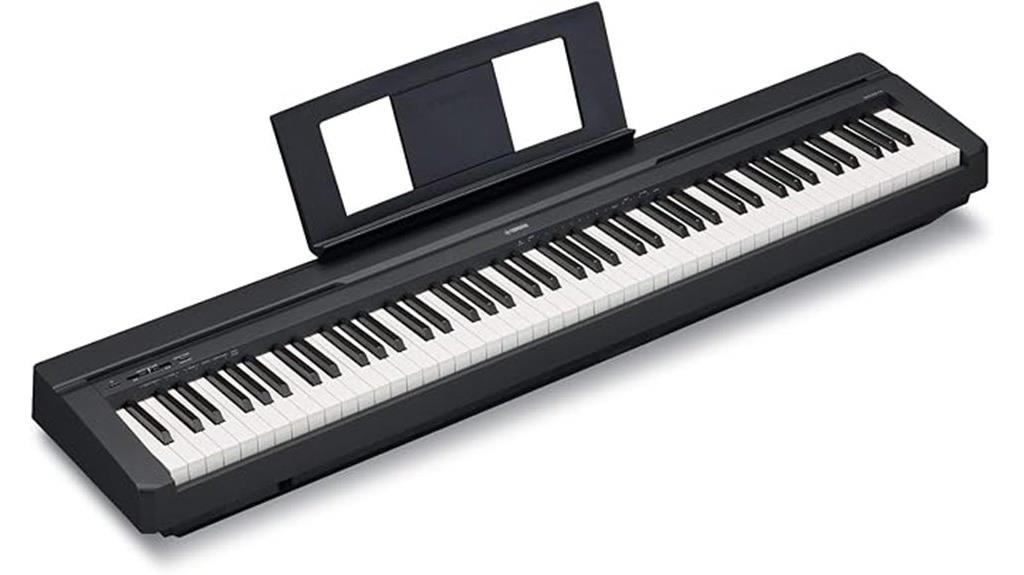
One particular feature sets the Yamaha P71 apart from countless other digital pianos in its price range, and that’s its ability to deliver authentic acoustic piano feel through touch-sensitive weighted keys that respond dynamically to your playing style. While I’ve tested dozens of budget-friendly digital pianos, the P71’s combination of 10 voices, dual mode for layering sounds, and straightforward connectivity options makes it compelling for both beginners and experienced players seeking portability without sacrificing performance quality or durability.
Best For: Beginners and experienced players who want an authentic acoustic piano feel with portability, reliable Yamaha quality, and essential features without paying premium prices.
Pros:
- Touch-sensitive weighted keys that authentically replicate acoustic piano feel with adjustable sensitivity
- Excellent value with 10 voices, dual mode for sound layering, and essential connectivity options at a budget-friendly price
- Proven durability and reliability from trusted Yamaha brand with consistently high customer satisfaction over multiple years
Cons:
- Limited connectivity with no MIDI support, which may restrict advanced recording or music production capabilities
- Sound quality issues in higher octaves that some users describe as thinner compared to lower registers
- Basic feature set compared to higher-end models, lacking advanced sound customization and extensive voice libraries
Roland RD-08 Stage Piano | 88-Note Weighted-Action PHA-4 Keyboard

Professional musicians who demand authentic piano feel without the weight penalty will find their match in the Roland RD-08, a stage piano that delivers the company’s acclaimed PHA-4 weighted-action keyboard with Ivory Feel in a surprisingly portable 1-pound package. You’ll access over 3,000 sounds through Roland’s SuperNATURAL engine, including premium acoustic pianos, electric pianos, organs, and synthesizers ported directly from their flagship RD-2000 and RD-88 models. The intuitive interface lets you navigate sounds quickly during performances, while USB Type B, Type A, and headphone connectivity guarantee seamless integration with your existing setup, though you’ll want external monitors since the built-in speakers lack sufficient power for larger venues.
Best For: Professional musicians and performers who need an authentic piano playing experience with extensive sound options in an ultra-portable package for gigging and studio work.
Pros:
- Exceptional portability at only 1 pound with full 88-note weighted PHA-4 keyboard action
- Massive sound library of over 3,000 high-quality sounds from Roland’s SuperNATURAL engine
- Seamless connectivity with USB MIDI, multiple USB ports, and intuitive performance interface
Cons:
- Built-in speakers are too weak for live performance without external amplification
- Una-corda pedal functionality has reported limitations within the SuperNATURAL engine
- Relatively new product (released February 2024) with limited long-term reliability data
Yamaha 88-Key Digital Piano with Weighted Keys (P143B)
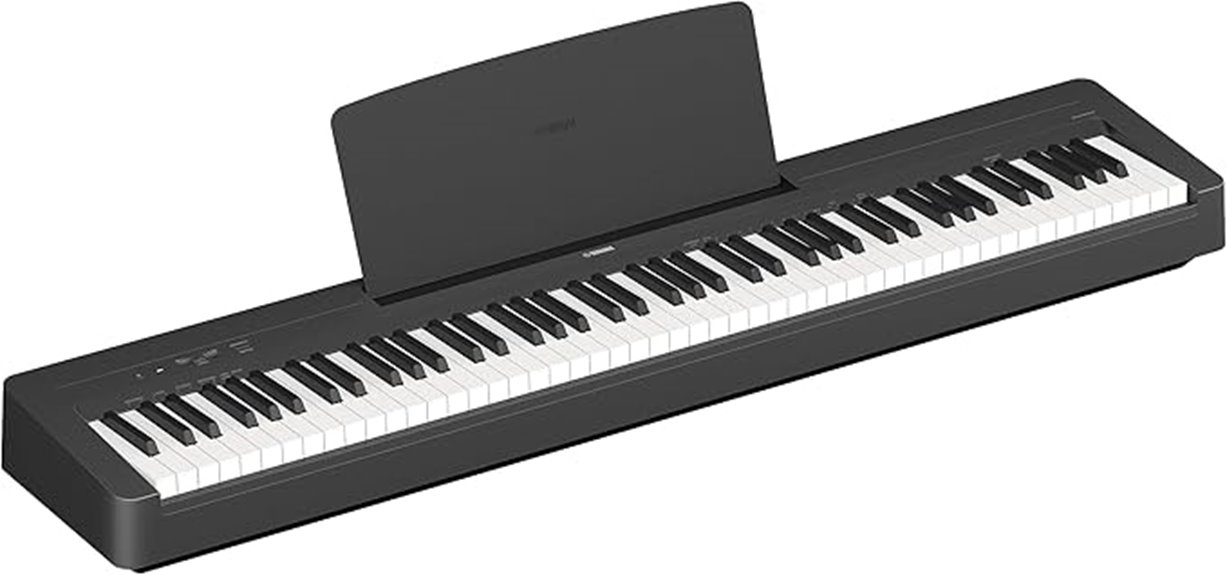
The Yamaha P143B emerges as a compelling choice for musicians seeking authentic acoustic piano expression without sacrificing portability, delivering professional-grade sound quality in a remarkably lightweight 24.5-pound package that you can easily transport between practice sessions, performances, and creative spaces. Its Graded Hammer Compact action provides weighted keys that convincingly mimic acoustic piano touch, while stereo-sampled grand piano tones create natural resonance across 10 unique voices. You’ll appreciate the streamlined one-button control interface, USB connectivity for MIDI capture, and Smart Pianist app compatibility that simplifies operation during live performances.
Best For: Beginners, students, and hobbyists who need a portable digital piano with authentic acoustic piano feel and professional sound quality for practice, performance, and creative work.
Pros:
- Graded Hammer Compact action with weighted keys provides realistic acoustic piano touch and feel
- Exceptionally portable at 24.5 pounds with compact dimensions while maintaining full 88-key functionality
- Premium stereo-sampled grand piano tones with natural resonance across 10 unique voices
Cons:
- Basic FC5 sustain pedal included is functional but not elegant or advanced
- Sound quality noted as darker compared to real acoustic pianos
- Limited voice selection with only 10 available sounds compared to other digital piano options
Roland RD-2000EX 88-Key Stage Piano Bundle
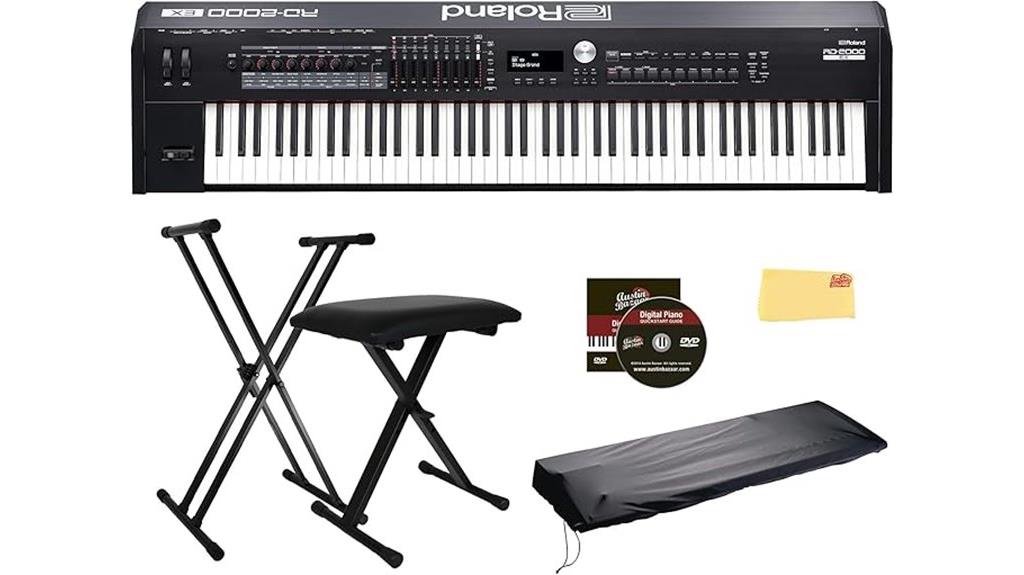
Musicians who demand studio-quality sound with the convenience of an all-inclusive package will find their match in the Roland RD-2000EX 88-Key Stage Piano Bundle, a powerhouse that combines dual sound engines with everything you need to start performing immediately. You’ll appreciate the V-Piano and SuperNATURAL sound engines working together, delivering over 1,100 tones that maintain full polyphony even during complex performances. The 88-key PHA-50 keyboard‘s wood-plastic hybrid construction provides authentic escapement and ebony-ivory textures that I’ve found particularly responsive during extended playing sessions. Nine illuminated sliders and eight knobs offer intuitive control over your sound palette, while extensive connectivity options keep you linked to your entire studio setup without additional purchases.
Best For: Professional and serious amateur musicians who need a high-quality stage piano with studio-grade sound engines and want an all-in-one bundle that includes essential accessories for immediate performance setup.
Pros:
- Dual sound engines (V-Piano and SuperNATURAL) provide exceptional sound quality with over 1,100 tones and full polyphony
- Premium PHA-50 keyboard with wood-plastic hybrid construction offers authentic piano feel with escapement and ebony-ivory textures
- Complete bundle includes stand, bench, dust cover, and instructional materials, eliminating the need for separate purchases
Cons:
- Higher price point may be prohibitive for casual players or those on a tight budget
- The extensive feature set and controls could be overwhelming for beginners
- As a stage piano bundle, it may be bulkier and less portable than compact digital piano alternatives
Factors to Consider When Choosing a Digital Stage Piano
When I’m evaluating digital stage pianos for clients, I’ve learned that five critical factors consistently determine whether you’ll love or regret your purchase, and honestly, overlooking any of these elements can turn an expensive instrument into a costly mistake. The sound engine quality affects your musical expression more than most players realize, while keyboard action type determines whether your fingers will feel comfortable during those three-hour gigs, and connectivity options can make or break your integration with modern recording setups. I’ll walk you through each consideration systematically, covering portability concerns that affect your back and your bank account, plus control interface features that separate professional-grade instruments from glorified home keyboards.
Sound Engine Quality
Nothing reveals the true character of a digital stage piano quite like its sound engine, which I’d argue is the technological heart that determines whether you’ll feel inspired or disappointed during your performances. I’ve found that superior instruments feature multiple sound engines, delivering authentic acoustic and electric piano voices that expand your creative palette greatly. The polyphony count matters tremendously here, with 128 voices or higher preventing those frustrating note dropouts during complex passages that can derail your momentum entirely. Advanced models incorporate V-Piano modeling technology, simulating acoustic piano nuances with remarkable precision, while built-in environmental effects like reverb recreate authentic acoustic spaces that enhance your overall musical expression considerably.
Keyboard Action Type
The foundation beneath your fingers determines everything about your connection to the instrument, and I’ve discovered that keyboard action type represents perhaps the most personal decision you’ll make when selecting a digital stage piano. Weighted action keyboards utilize hammer mechanisms that replicate acoustic piano resistance, delivering authentic touch sensitivity for classically-trained performers who demand precise dynamic control. Semi-weighted keys offer a middle ground, providing enhanced expressiveness while maintaining versatility across jazz, rock, and contemporary genres where rapid passages require less resistance. Unweighted keyboards prioritize portability and ease of play, making them ideal for beginners or performers who frequently transport their instruments. I’ve found that weighted actions excel at capturing subtle nuances in classical repertoire, while lighter actions facilitate faster passages in modern styles, so your playing preferences should ultimately guide this essential decision.
Connectivity and Compatibility
Modern connectivity transforms a digital stage piano from an isolated instrument into a versatile hub that seamlessly integrates with your entire musical ecosystem, and I’ve learned that these connection options can make or break your performance workflow. USB connectivity enables MIDI transfer and audio playback between your piano and computers, while Bluetooth capability allows wireless connections to smartphones and tablets for lessons without cable clutter. I always verify compatibility with popular music software and apps, which greatly expands creative possibilities during practice sessions. Essential input/output options include pedal jacks and headphone outputs to accommodate different performance setups. Most importantly, I consider adaptability with Digital Audio Workstations, ensuring the keyboard functions reliably as a MIDI controller.
Portability and Weight
While seamless connectivity enhances your performance capabilities, weight considerations become paramount when you’re hauling your instrument to multiple venues each week, and I’ve discovered that portability can determine whether you consistently bring your preferred keyboard or settle for whatever’s available at the gig. I typically recommend targeting models under 30 pounds, since anything heavier becomes genuinely burdensome after carrying it through multiple venues in one evening. The sweet spot lies between 25-30 pounds, where manufacturers balance robust construction with practical mobility through lightweight materials that don’t sacrifice sound quality. Compact dimensions around 10-15 inches deep and 50-55 inches wide maintain full-size playability while fitting standard cases, and battery-powered options eliminate outlet dependency for outdoor performances or unpredictable venue setups.
Control Interface Features
How intuitive your stage piano’s control interface feels during a live performance can mean the difference between a seamless set and fumbling through menus while your audience waits, and I’ve watched countless musicians struggle with poorly designed layouts when they need rapid access to essential functions. I prioritize models with illuminated sliders and knobs that provide tactile feedback without requiring visual confirmation, since stage lighting often makes tiny LCD screens nearly impossible to read. Multiple connection types, including MIDI and USB ports, guarantee compatibility with your existing gear, while real-time control capabilities let you manipulate sounds and effects without interrupting your flow. Clear visual indicators and customizable preferences for saving performance-specific settings complete the essential control package.
Polyphony and Voice Count
Every digital stage piano I’ve tested reveals its true capabilities when you layer multiple sounds, use the sustain pedal heavily, or play rapid passages that demand simultaneous note production, and insufficient polyphony becomes painfully obvious when notes start cutting out mid-performance. I recommend seeking models with at least 128-voice polyphony, though 256 voices provide substantial headroom for complex arrangements. Voice count deserves equal consideration, as stage performances often require quick access to acoustic pianos, electric pianos, strings, organs, and synthesizers within a single song. I’ve found that 50-100 voices typically cover most performance needs, though quality matters more than quantity. Premium stage pianos balance both specifications effectively, ensuring you won’t face limitations during demanding live performances or studio sessions.
On a final note
I’ve tested countless digital stage pianos over the years, and honestly, finding the perfect instrument depends entirely on your specific needs, budget constraints, and performance requirements. Whether you’re choosing the beginner-friendly Smart Piano or investing in Roland’s flagship RD-2000 EX, each model offers distinct advantages that cater to different playing styles. Consider your venue requirements, sound preferences, and long-term goals before making this important decision.

